This page was generated from
docs/examples/DataSet/Threaded data acquisition.ipynb.
Interactive online version:
.
Threaded data acquisition¶
In this notebook, we will explore how threading can be used with measurement context manager or dond functions for faster data acquisition. It is important to note that, the threading QCoDeS provideds happens per instrument. Meaning, per instrument one thread is created and all parameters from same instrument gets assigned to the same thread for data acquizition. It is generally not safe for more than one thread to communicate with the same instrument at the same time.
Let us begin with some necessary imports.
[1]:
%matplotlib inline
import time
from pathlib import Path
import numpy as np
import qcodes as qc
from qcodes.dataset import (
Measurement,
ThreadPoolParamsCaller,
do1d,
initialise_or_create_database_at,
load_or_create_experiment,
plot_dataset,
)
from qcodes.instrument_drivers.mock_instruments import (
DummyInstrument,
DummyInstrumentWithMeasurement,
)
from qcodes.parameters import Parameter
from qcodes.validators import Numbers
[2]:
# configure the plots generated in this example to go to the example_output folder
qc.config.user.mainfolder = Path.cwd().parent / "example_output"
Now, setup some instruments!
[3]:
dac = DummyInstrument("dac", gates=["ch1", "ch2"])
dmm1 = DummyInstrumentWithMeasurement(name="dmm1", setter_instr=dac)
dmm2 = DummyInstrumentWithMeasurement(name="dmm2", setter_instr=dac)
[4]:
class SleepyDmmExponentialParameter(Parameter):
def __init__(self, name, **kwargs):
super().__init__(name, **kwargs)
self._ed = self._exponential_decay(5, 0.2)
next(self._ed)
def get_raw(self):
dac = self.root_instrument._setter_instr
val = self._ed.send(dac.ch1())
next(self._ed)
time.sleep(0.1)
return val
@staticmethod
def _exponential_decay(a: float, b: float):
x = 0
while True:
x = yield
yield a * np.exp(-b * x) + 0.02 * a * np.random.randn()
The above parameter class is made to return data with a delay on purpose with help of time.sleep(0.1) statement in the get_raw method to simulate slow communication with actual instruments.
[5]:
dmm1.add_parameter(
"v3",
parameter_class=SleepyDmmExponentialParameter,
initial_value=0,
label="Gate v3",
unit="V",
vals=Numbers(-800, 400),
get_cmd=None,
set_cmd=None,
)
[5]:
<__main__.SleepyDmmExponentialParameter: v3 at 140043126167888>
[6]:
dmm2.add_parameter(
"v3",
parameter_class=SleepyDmmExponentialParameter,
initial_value=0,
label="Gate v3",
unit="V",
vals=Numbers(-800, 400),
get_cmd=None,
set_cmd=None,
)
[6]:
<__main__.SleepyDmmExponentialParameter: v3 at 140042179928656>
Initialize the database and load or create an experiment.
[7]:
initialise_or_create_database_at(
Path.cwd().parent
/ "example_output"
/ "data_acquisition_with_and_without_threads.db"
)
exp = load_or_create_experiment(
experiment_name="data_acquisition_with_and_without_threads", sample_name="no sample"
)
Measurement 1: Non threaded data acquisition¶
In the following measurment, we do not use threads and note down the time taken for the data acquisition.
[8]:
meas1 = Measurement(exp=exp, name="exponential_decay_non_threaded_data_acquisition")
meas1.register_parameter(dac.ch1)
meas1.register_parameter(dmm1.v3, setpoints=(dac.ch1,))
meas1.register_parameter(dmm2.v3, setpoints=(dac.ch1,))
[8]:
<qcodes.dataset.measurements.Measurement at 0x7f5e1c678f90>
[9]:
data_acq_time = 0
with meas1.run() as datasaver:
for set_v in np.linspace(0, 25, 10):
dac.ch1.set(set_v)
t1 = time.perf_counter()
datasaver.add_result(
(dac.ch1, set_v), (dmm1.v3, dmm1.v3.get()), (dmm2.v3, dmm1.v3.get())
)
t2 = time.perf_counter()
data_acq_time += t2 - t1
dataset1D1 = datasaver.dataset
print("Report:")
print(f"Data acquisition time: {data_acq_time} s")
Starting experimental run with id: 1.
Report:
Data acquisition time: 2.005900072999907 s
[10]:
ax, cbax = plot_dataset(dataset1D1)
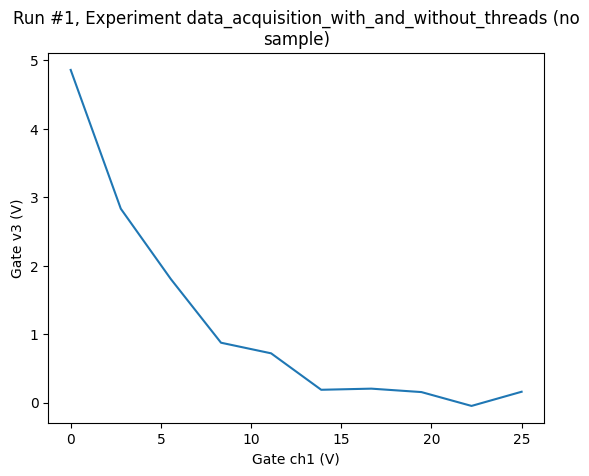
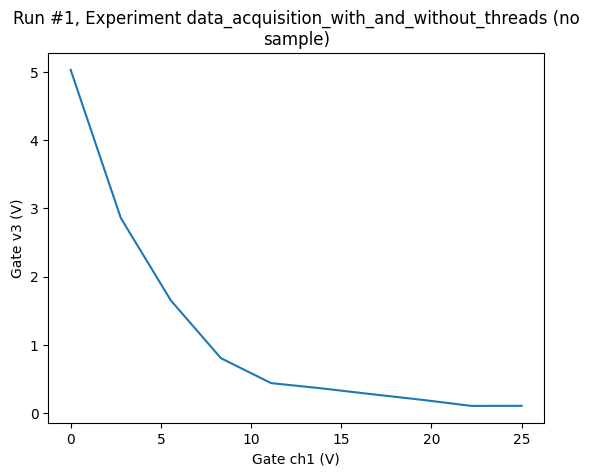
Measurement 2: Threaded data acquisition¶
In this measurement, we use ThreadPoolParamsCaller for threaded data acquisition. Here also we record the time taken for data acquisition.
ThreadPoolParamsCaller will create a thread pool, and will call given parameters in those threads. Each group of parameters that have the same underlying_instrument protperty will be called in it’s own separate thread, so that parameters that interact with the same instrument are always called sequentially (since communication within the single instrument is not thread-safe). Thanks to the fact that the pool of threads gets reuse for every new call of the parameters, the performance
penalty of creating and shutting down threads is not significant in many cases.
If there is a benefit in creating new threads for every new parameter call, then use call_params_threaded function instead.
[11]:
meas2 = Measurement(exp=exp, name="exponential_decay_threaded_data_acquisition")
meas2.register_parameter(dac.ch1)
meas2.register_parameter(dmm1.v3, setpoints=(dac.ch1,))
meas2.register_parameter(dmm2.v3, setpoints=(dac.ch1,))
[11]:
<qcodes.dataset.measurements.Measurement at 0x7f5e1b3de6d0>
[12]:
pool_caller = ThreadPoolParamsCaller(
dac.ch1, dmm1.v3, dmm2.v3
) # <----- This line is different
data_acq_time = 0
with (
meas2.run() as datasaver,
pool_caller as call_params_in_pool,
): # <----- This line is different
for set_v in np.linspace(0, 25, 10):
dac.ch1.set(set_v)
t1 = time.perf_counter()
datasaver.add_result(*call_params_in_pool()) # <----- This line is different
t2 = time.perf_counter()
data_acq_time += t2 - t1
# With ``call_params_threaded`` this line that measures parameters
# and passes them to the datasaver would be:
# datasaver.add_result(*call_params_threaded((dac.ch1, dmm1.v3, dmm2.v3)))
dataset1D2 = datasaver.dataset
print("Report:")
print(f"Data acquisition time: {data_acq_time} s")
Starting experimental run with id: 2.
Report:
Data acquisition time: 1.007553625000014 s
[13]:
ax, cbax = plot_dataset(dataset1D2)
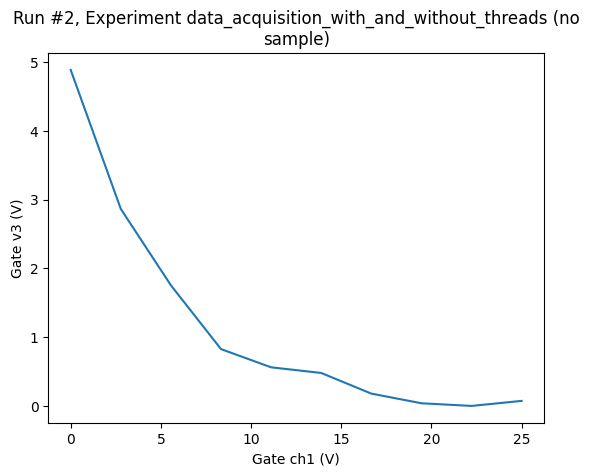
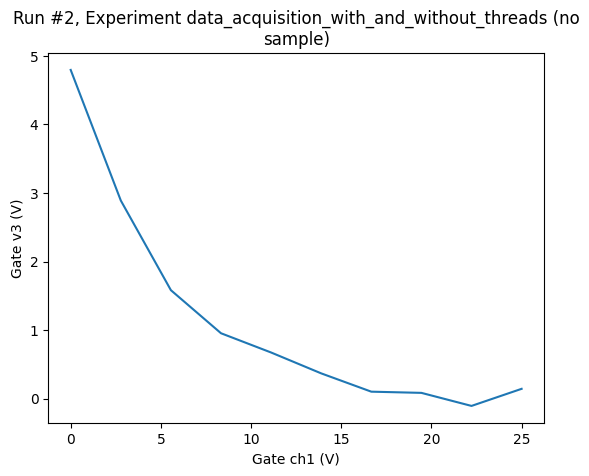
Non threaded and threaded data acquisition with do1d¶
Lets now see how to do non threaded and threaded data acquisition with do1d function. For threaded data acquisition, use_threads argument will be set to True. Same argument is available on do0d, do2d and dond functions.
Measurement 3: Non threaded data acquisition with do1d¶
[14]:
t0 = time.perf_counter()
do1d(dac.ch1, 0, 1, 10, 0, dmm1.v3, dmm2.v3, do_plot=True)
t1 = time.perf_counter()
print("Report:")
print(f"Data acquisition time: {t1 - t0} s")
Starting experimental run with id: 3. Using 'qcodes.dataset.do1d'
Report:
Data acquisition time: 3.0019839729999944 s
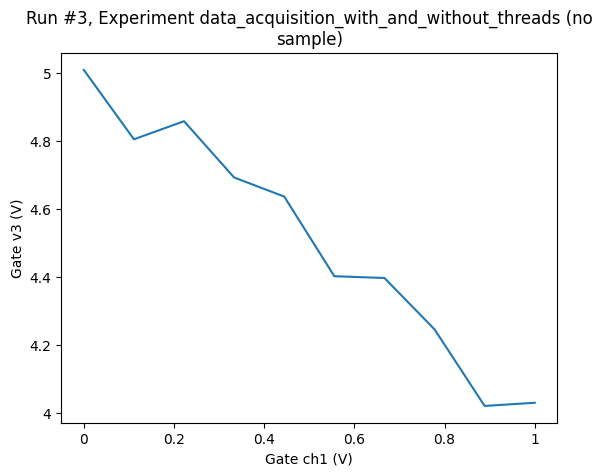
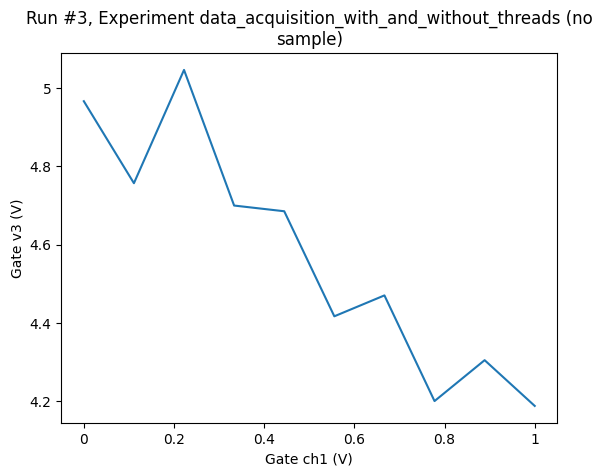
Measurement 4: Threaded data acquisition with do1d¶
[15]:
t0 = time.perf_counter()
do1d(
dac.ch1, 0, 1, 10, 0, dmm1.v3, dmm2.v3, do_plot=True, use_threads=True
) # <------- This line is different
t1 = time.perf_counter()
print("Report:")
print(f"Data acquisition time: {t1 - t0} s")
Starting experimental run with id: 4. Using 'qcodes.dataset.do1d'
Report:
Data acquisition time: 1.8658279389999848 s

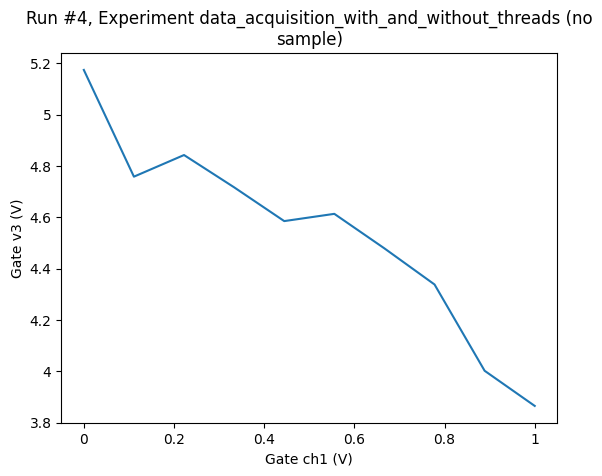
[ ]: